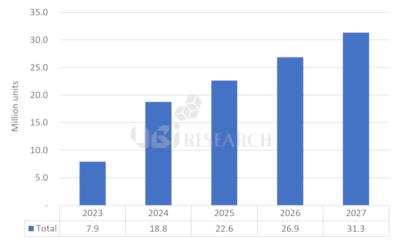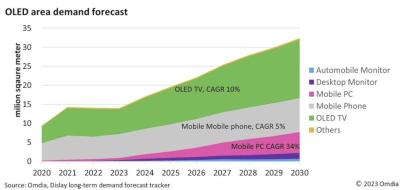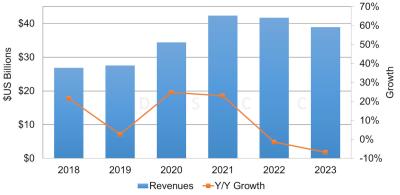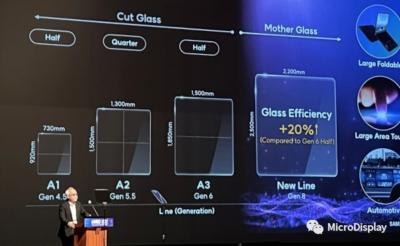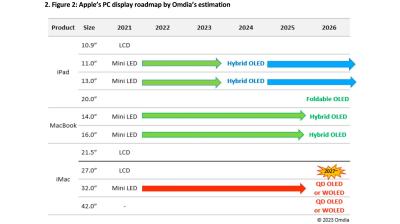OLED Tablets - Introduction and Latest Industry News - Page 5
UBI: The OLED IT panel market will grow at a CAGR of 41% to reach 31 million units by 2027
UBI Research estimates that 7.9 million AMOLED displays for IT applications (tablets, notebooks and monitors) will ship in 2023, growing to 31 million by 2027 (a CAGR of 41%). Apple's adoption of OLED screens starting in 2024 will fuel much of the demand.
OLED makers, led by Samsung, LG, BOE and Visionox are all expected to start producing IT OLED panels in existing 6-Gen production lines, and companies are also planning to construct new dedicated 8.5-Gen lines for IT applications.
Japan Display aims to start eLEAP laptop OLED production by 2025
Japan Display (JDI) plans to start producing medium-sized OLED displays, to be used in tablets and laptops. The company hopes to start producing the first panels (which will be around 14-inch in size) by 2025.

Asus ZenBook 17 Fold OLED (BOE panel)
Up until now, JDI focused on the production of wearable OLED displays, selling its panels for Apple's smartwatches since 2019. The company's production volume was limited, and so was its technology capabilities to increase production panel sizes. It will be interesting to see whether JDI hopes to also supply its future laptop/tablet panels to Apple.
Omdia: the OLED market by area will grow to over 30 million sqm in 2030
Market research firm Omdia says that according to its latest forecast, the OLED market will grow at a CAGR of 11% from 2022 to 2030, by total display production area.
The main OLED application is smartphone displays, and Omdia says that in 2022 the penetration of OLED displays into that market reached 42%. The market share of OLED smartphones will rise steadily in the future. The OLED TV market is experiencing a slowdown, but Omdia says it will resume growth in 2024.
Samsung announces new foldable phones, tablets and smartwatches, all based on AMOLED displays
Samsung announced several new devices today, all utilizing AMOLED displays. We'll start with the two new foldable phones, the Galaxy Z Fold5 and Z Flip5. The Fold5 offers a foldable 7.6" 120Hz 1812x2176 foldable AMOLED display, and a 6.2" 120Hz 904x2316 cover AMOLED. The phone has a Snapdragon 8 Gen 2 chipset, 12 GB of RAM, up to 1TB of storage and a triple camera setup.
Samsung's Galaxy Z Flip5 smartphone offers a foldable 6.7" 120Hz 1080x2640 foldable AMOLED display, and a small 3.4" 720x748 cover Super AMOLED display. The phone has a Snapdragon 8 Gen 2 chipset, 8 GB of RAM, up to 512GB of storage and a dual camera setup.
DSCC: OLED panel revenues to decline in 2023, in a second consecutive year
DSCC says that OLED panel revenues will decline 7% in 2023 (to $38.9 billion), the second consecutive year that the OLED market is seeing a decline in sales. The largest declines will be in the OLED TVs and laptops segments.
The OLED smartphone market will actually grow 4% in unit sales, but revenues will decline 5%. The OLED TV market will decline 29% in 2023 in both revenues and units. OLED laptop unit sales will decline by 15%. All other segments, including AR/VR, automotive and tablets, will grow in sales and revenues in 2023.
Merck launches new highly-effective ALD OLED encapsulation materials
Merck introduces new OLED encapsulation materials that the company says offer superior flexibility, higher reliability, and longer lifetime for flexible devices compared to existing solutions.
Merck says that its new low-temperature ALD silicon materials offer highly improved barrier characteristics - 100 times more effective than current solutions. And they can be deposited in thin layers - 20 times thinner than existing solutions. Merck introduced low-temperature ALD silicon materials in 2022 for automotive OLED, and the company expects that the new materials will be used for the encapsulation of flexible IT OLED displays (laptops, tablets and monitors).
BOE is facing delays in its plan to build an 8.5-Gen IT OLED line
BOE has plans to construct an 8.5-Gen AMOLED production line with a capacity of 30,000 monthly substrates to produce IT displays for laptops, tablets and monitors. The company aims to build the B16 factory in Chengdu, Sichuan.

Asus ZenBook 17 Fold OLED (BOE panel)
According to Korea's ETNews, BOE is facing delays with its B16 plans. The company is seeking support from the local government, but it has yet to gain support.
Samsung Display starts ordering equipment for its 8.6-Gen IT OLED production line
According to report from Korea, Samsung Display has established a dedicated organization to head its new 8.6-Gen IT OLED Production line, and has started to order equipment. Samsung is converting an existing LCD line in Asan to OLED production, with an estimated cost of $3.1 billion.
According to the report, SDC's decision to have a dedicated organization was made to give that team independence from the company's current small-area (smartphone/wearable) focused business and TV-focused business.
A slowdown in Apple's laptop sales may delay Samsung's and LG's investment in OLED IT production lines
Samsung Display and LG Display are both gearing up to build 8-Gen AMOLED production lines, aiming to supply Apple (and others) with OLEDs for IT devices - laptops and tablets, mostly. Last month Samsung announced that it will convert an existing LCD line in Asan to OLED production, with an estimated cost of $3.1 billion.
According to a new report from Korea, the slowdown in Apple's laptop sales is a cause of worry for the OLED producers, who have delayed the plans to build the new fabs, and delayed equipment orders. The main problem for the OLED makers is that the slowdown in Apple's sales may drive Apple to want to low the price of the laptop displays, which would put a stress on the profitability of new OLED fabs.
Omdia: Apple to switch to OLED displays in almost all of its tablets, laptops and monitors by 2027
Omdia released its latest IT OLED display forecasts, with some interesting projections.
The company sees very nice growth ahead for OLED displays in the IT market, with shipments rising from around 9.7 million units in 2022 to over 70 million units in 2028. Most of the growth will come from adoption in laptops, but tablet adoption will also increase sharply.
Pagination
- Previous page
- Page 5
- Next page
